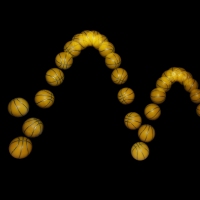 Whenever you are singing fast, energetic songs, the music will sound good if you make small accents on the notes. In this way you are emphasizing the rhythmical character of the music. We might call this ‘percussive’ singing. It is opposite to the classical way of legato singing.
Whenever you are singing fast, energetic songs, the music will sound good if you make small accents on the notes. In this way you are emphasizing the rhythmical character of the music. We might call this ‘percussive’ singing. It is opposite to the classical way of legato singing.
The term ‘legato’ is common in classical music. It indicates that you should bind the notes, preventing gaps between them. But at the same time the term is used to indicate that the notes should keep their volume, creating a continuous sound. We might depict legato like this:
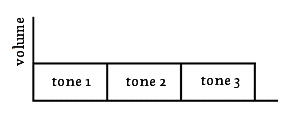 Certain instruments are more suitable to play legato than others. A violin or an organ for example can sound this way very well. A clavichord or a marimba on the other hand are not suited for legato, because the sound decays quickly.
Certain instruments are more suitable to play legato than others. A violin or an organ for example can sound this way very well. A clavichord or a marimba on the other hand are not suited for legato, because the sound decays quickly.
Rhythms
In jazz people do not play legato a lot. These musicians prefer a way of playing in which the rhythms are conveyed strongly. The double bass for example is not played by drawing a bow, but rather by picking. The notes start strongly and have a fast decay: This kind of playing is very important in pop and jazz. But unfortunately, there is no expression for it. Whenever I want this kind of sound from my choir, I am asking for a ‘percussive’ way of making the notes. A good alternative term might be ‘bouncing’, because the notes appear to be jumping off.
This kind of playing is very important in pop and jazz. But unfortunately, there is no expression for it. Whenever I want this kind of sound from my choir, I am asking for a ‘percussive’ way of making the notes. A good alternative term might be ‘bouncing’, because the notes appear to be jumping off.
Singing
The human voice is a very flexible instrument. It can be either legato or percussive. Imagine a choir singing I got rhythm by Gershwin in a legato way. This would look like this:
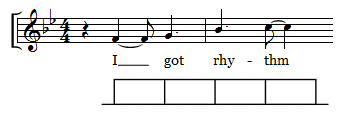
Each note retains its volume until the next note is starting.
If we are singing these notes legato, the rhythm will not be conveyed strongly. A percussive way of singing is far more attractive for this kind of music:
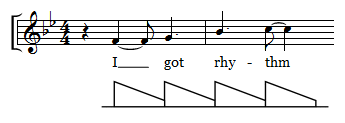
Each note is starting loud and is quickly getting softer. In this way the onset of the notes will draw the most attention.
Staccato
We should mention the term ‘staccato’ in this context. In classical music staccato is often opposed to legato. It indicates that notes are shortened, creating blanks in between the notes:
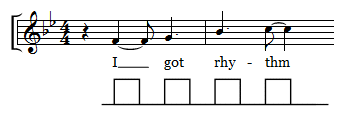
The images above show that staccato singing is not the same a percussive singing. In jazz and pop, staccato singing is not a good alternative for percussive singing. In a melody with lyrics, making the notes staccato sounds awkward and clumsy. The musical line will sound fragmented and fainted.
Notation
For percussive singing, as we said earlier, there is no generally used term. As a result, there doesn’t exist a way to notate this way of performing the notes. Writing down accents might get close:

In practice, however, the arranger should let the percussive singing up to the performers. Hopefully the singers and the conductor use this way of singing, because they understand it is part of the style.